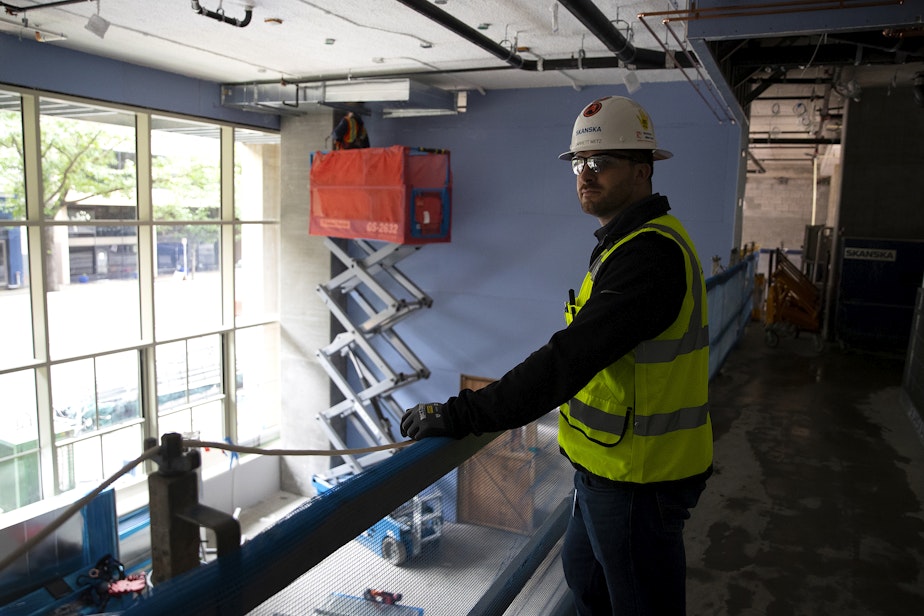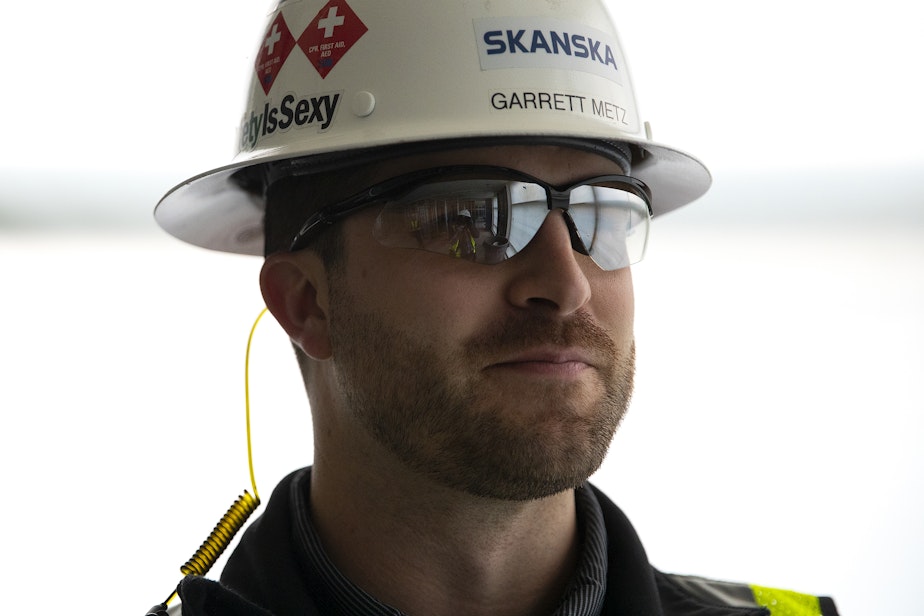Robots are helping build new apartments in Seattle

The construction industry has been having a hard time finding enough workers lately. The worker shortage can delay projects and push the cost of housing higher.
That situation has led one contractor to try something new at a project in Seattle — they’re bringing in a robot.
Garrett Metz was managing a 31-story apartment tower under construction in Belltown. Every day, he'd visit every room on every floor and take a photo, hundreds of photos every day.
So, how did he like that work?
"It, uh, wasn't very thrilling, if that's what you're asking," Metz says.
Sponsored
RELATED: How a dog-like robot is training for space exploration on Mount Hood
A few other employees shared the load, but when you added their time together, this kind of repetitive work consumed dozens of hours a week.
Those photos went into a sort of database, so people could track a building's progress over time, and notice when things were not installed when they should be. It's important work, but Metz wanted to do more interesting things.
"I prefer working through problems with engineers and architects and subcontractors," he says.

Skanska, the development and construction company, could have brought in a less-experienced worker to do the work Metz doesn't want to do anymore. But contractors have been having trouble attracting young talent, who seem more drawn to technology jobs. Meanwhile, older construction workers are retiring.
So Metz' bosses brought in a robot.
Didge is actually a small swarm of robots controlled by a single mind. Each robot controls a different section of the tower.
RELATED: Downtown Seattle office values are dropping like overripe plums. That's not all bad
Didge works as a kind of manager. It doesn't boss people around. But it did take over the tedious task of taking photographs of every room from Garrett Metz.
It uses artificial intelligence to review those photographs, find problems, and flag them for human managers.
Now, Metz has more time for troubleshooting.
"So like, for instance, today, we were in a meeting, talking about quality control for the project, right?" Metz said. "And we were going through a list and things would come up, 'Hey, is this hole in this drywall in this room patched?'
"And I'd pull up the photos. Sure enough, photo was taken a couple of days ago. And sure enough, the wall was patched.

"So instead of me having to go out there with the photo camera every day tracking it, by myself up on these floors after hours, usually after all the crews are home, I'm able to just pull it up in real time in meetings, discuss it and use it as a tool for coordination."
Sponsored
Metz says he's not resentful that a robot has taken a portion of his job.
"Absolutely not," he says. "There's there's plenty of work to go around for everyone."
So, that's one guy who doesn't feel threatened by a robot doing his job.
But what about other kinds of workers? The people who swing hammers, lay electrical wire, and install plumbing fixtures?
Sponsored
Most of these jobs require human dexterity and ingenuity, something robots are not as good at, yet.
That’s one reason trade unions aren't scared that robots will make their workers’ skills obsolete, says Monty Anderson, executive secretary of the Seattle Building & Construction Trades Council, which represents 19 unions with over 15,000 workers.
In fact, Anderson says some of those unions are buying their own robots.
Sponsored
Jordan Russeff is a spokesperson for the Cement Masons and Plasters Union Local 528 in Seattle.
"If we're not evolving with the tools of the trade, then we're left behind in the building phase," Russeff says. "So we just want to make sure that we have a crew ready and trained in these new technologies to be out there, able to perform the work."
Russeff's union recently bought a robot that prints out concrete walls, layer by layer.
Many workers fear that robots and AI will take their jobs. Does Russeff fear some of these technologies will lead to job losses in his union?
RELATED: Apple doubles down on artificial intelligence, announcing partnership with OpenAI
"I don't believe so," he says. "I think it's a new tool. I think you will still need someone to run that tool. And the nice thing about concrete and the reason that you need human interaction with it is because it's a 'live product.' You need to be able to make adjustments on the fly. And you have to be able to time it correctly and read the concrete and be able to hit it at the right time... to be able to get a good finish on it."
Sponsored
The 3D printer allows for possibilities that didn’t exist before. For example, it can print out curved concrete walls without the need for complicated concrete forms.
That could lead to more work for cement masons and plasterers, especially if they're called in to build printed walls that otherwise would have been assembled by a carpenter out of wood.
Now the union is promoting its new skills to architects and engineers. It’s saying: “Look what we can do now.”
Learn more on the latest episode of KUOW's podcast, Booming:


